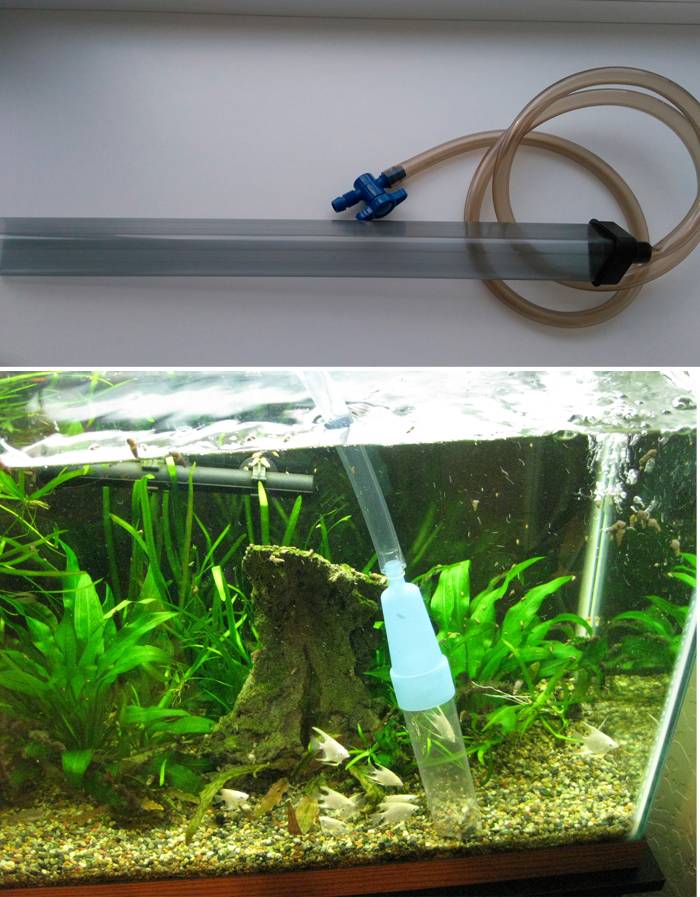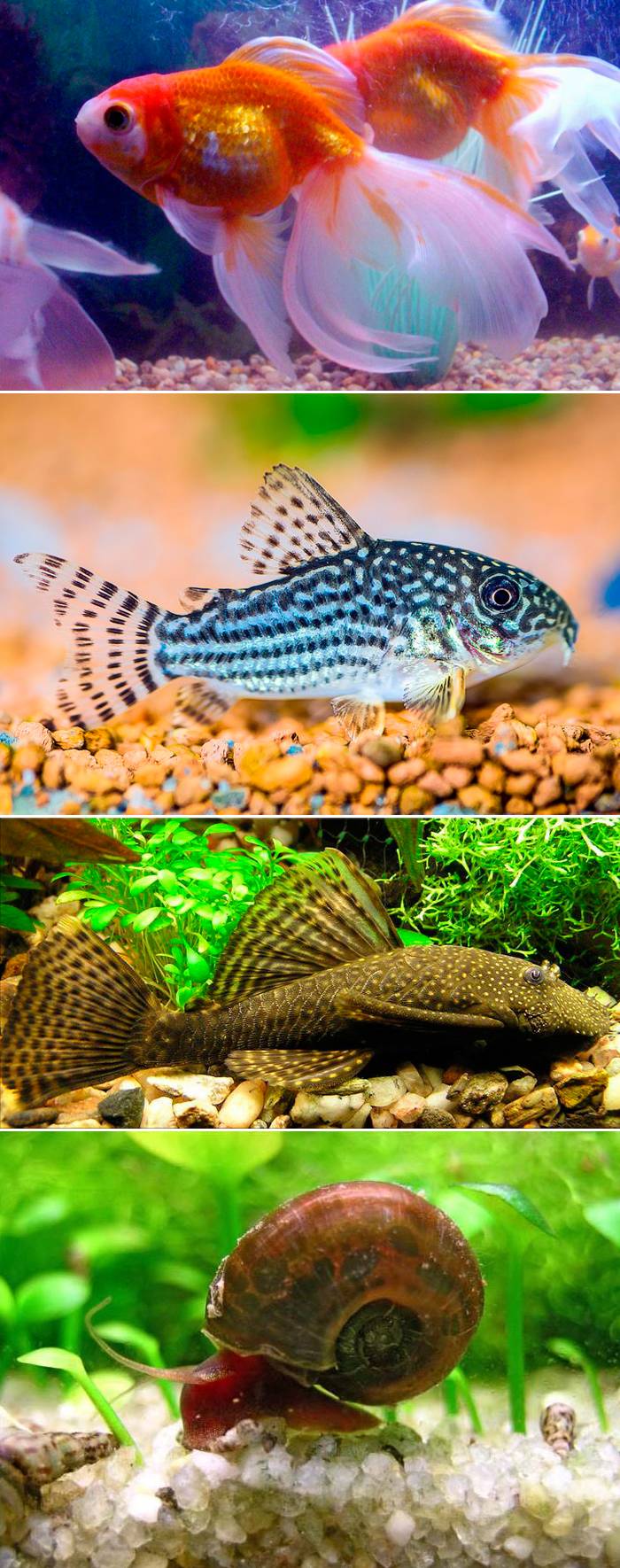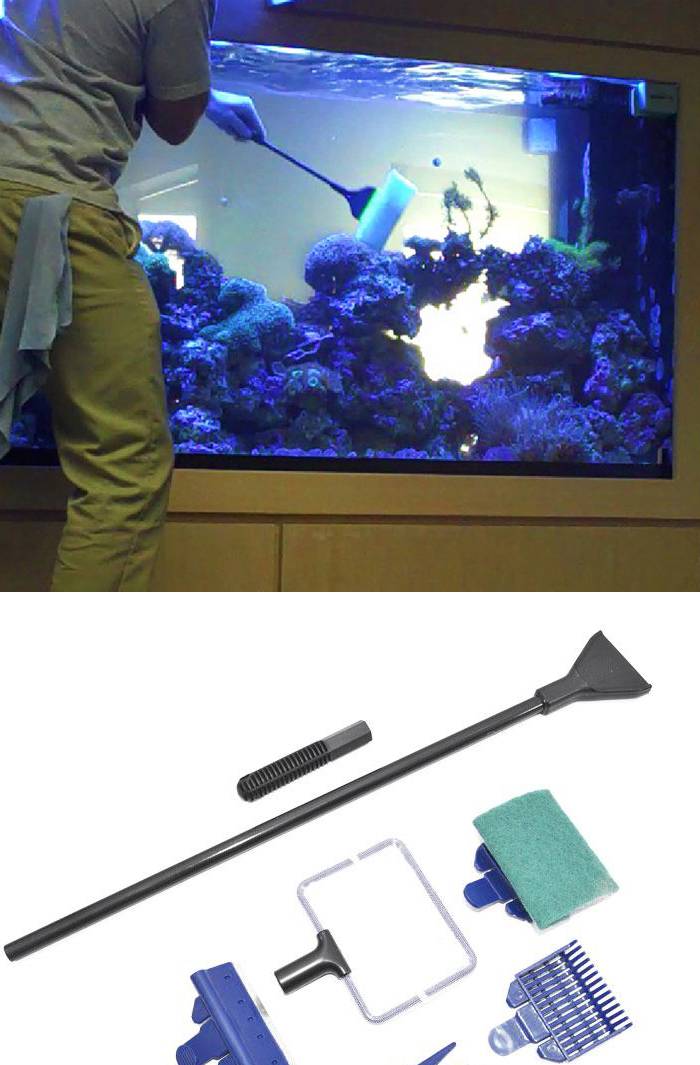This article will cover all questions about cleaning the aquarium and its contents. But let's say right away that washing should be carried out at least once a week. At the same time, partially change the water, but in no case completely, otherwise the fish will feel bad.

How often should you do general cleaning in the aquarium
Regardless of the size of the aquarium, its volume and number of inhabitants, it is imperative to regularly clean it in order to maintain a favorable environment inside it and a beautiful appearance outside.
According to experienced aquarists, cleaning can be divided by frequency into 3 types:
- Daily. It includes the removal of food and fish waste from the bottom. It is carried out using a special tube - a siphon.
- Weekly. This is the most serious and important process that requires a lot of time and patience. This includes cleaning glass, decor and vegetation, filters, soil "siphon", water change. Some of the listed procedures are optional for weekly cleaning, you need to look at the condition. If, for example, the filters are not dirty and work well, you can postpone washing them until the next cleaning.
- Semi-annual means "starting" the aquarium from the very beginning with a complete replacement of water, radical cleaning of all contents and relocation of living creatures. This is done in extreme cases, for example, after an epidemic.
Aquarium cleaning algorithm
Here are the basic steps for a general cleaning of an aquarium:
- Cleansing the walls from the inside from green plaque. In any aquarium, the appearance of algal bloom is absolutely normal. For the preservation of the aesthetic look, simply “remove” it regularly.
- Scenery cleaning. Rocks, shells, grottoes and artificial plants also turn green and require washing.
- Plant processing. The flora of an artificial reservoir needs weeding, pruning and planting, but this should be done as it grows, and not every week.
- "Siphon" of soil. Removal of organic contaminants from the bottom.
- Water change.
Important! A water change does not mean a complete water change. It talks about partially draining the old one, and adding a new one. For fish, the established microclimate is very important and they can get sick and die from frequent water changes.
- Cleaning the filters. The need for this procedure can be determined by the pressure of the filter jet, if it has become weak, then it is time to rinse it.
- Filling with clean water. The water change should be between 15% and 50% at a time. The more clean "uninhabited" water is poured, the more painfully the fish will endure general cleaning.
Step-by-step instructions for cleaning an aquarium
1. First of all, clean the walls. For the inside, there is no need to drain the water. A special scraper with a handle is very convenient, but you can do with improvised means, for example, use a regular sponge.
Carefully remove any green residue. To clean a large aquarium, you can use a magnetic scraper, it is easy to use and thoroughly cleans the entire area, however, there is a minus: it does not clean dirt from hard-to-reach places and corners.
2. Then clean the decor. To do this, pull it out and rinse it under running water with a stiff brush or sponge.
Do not use detergents and cleaning agents!
3. Pay your attention to the plants. If the algae have grown strongly and have begun to interfere with the free movement of fish, it is necessary to thin them out. First, cut off all the damaged leaves that are visually clearly visible. Then divide the overgrown bushes and remove the excess. Abundant vegetation should not interfere with light penetration. If you need to remove the plant from the root, do it with extreme caution so as not to raise the dregs from the bottom.
It is important to remember that aquarium plants do not tolerate transplants and any other manipulations poorly, so they need to be removed as they grow, and not with each cleaning.
Fun Fact: If there is a need to remove green unicellular algae that cause water bloom, hydrogen peroxide can be used. To do this, inject it within 5-7 days with a syringe, 2-2.5 ml per 10 liters of water. The effect will be noticeable on the third day.
4. Use a siphon. After cleaning the walls and all the contents of the aquarium from plaque, as well as weeding the plants, a huge amount of turbidity and organic dirt is formed in the water. In this case, it is necessary to "siphon" the soil, and at the same time to partially drain the water. This can be done using an ordinary thin hose or a special aquarium siphon.

Place one end of the tube in an aquarium and suck up dirty, cloudy water into a specially prepared container. Drain no more than 50% of the water. Experienced aquarists substitute from 1/3 to 1/5, depending on the volume of the reservoir, and the whimsicality of the pets.
5. Clean the filter. Take this stage with great responsibility. The filter accumulates a huge amount of beneficial living bacteria that help maintain a normal biological balance. No need to wash and scrub it thoroughly, you can wash it lightly in aquarium water.
Do not use running water! This can harm the health of the inhabitants. Ceramic filters only need to be washed once a month.
6. Add water. This should be done at the very end - after when all the "dirty" work is over. The water for the change must be clean and settled in a covered container for at least a week. When filling, you can add some vitamins to the aquarium, which are sold at pet stores.
Fish - orderlies
The inhabitants themselves can become assistants in cleaning a home pond. For example: Goldfish, Coridoras, Ancistrus, Girinoheilus, Siamese algae, Snails, Shrimps. And that's not all of the nursing inhabitants. However, they all begin to peel off plaque only when there is a shortage of feed, so they are just helpers.

Aquarium cleaners
The main thing to remember is that it is strictly forbidden to use chemical, soap, chlorinated agents to treat the aquarium and its contents!
In extreme cases, use soda, soap, "Domestos", "Komet", but after using these funds, you must rinse the aquarium very carefully several times under running water. Those. this can be done only with a six-month cleaning, and not every week.
The universal scraper is very convenient in that you can choose the length of the handle to the height of the wall and clean it without even wetting your hands in water. There is also a magnetic scraper, it is generally made specifically for aquariums, it is very convenient because it is controlled from the outside of the glass.

The siphon is also a special attribute for cleaning a home pond, it looks like a tube with a tip and serves to remove organic waste from the bottom of the aquarium. It can be replaced with a regular thin hose.
The water filter is another special water purification device. It works from the mains, constantly purifies water, continuously absorbing small particles. There are mechanical filters that retain debris in the built-in sponge, and chemical filters - they purify water using activated carbon.
Initial treatment of a new aquarium
The new aquarium, as well as decorative accessories and substrate, rinse with warm running water using a sponge without adding chemical detergents.
Do not use hot water!
For reliability, use regular baking soda, but after that, rinse the container thoroughly under strong pressure at least 4 times. Carry out the last rinse with water without chlorine impurities, for this it must settle well.
The most common mistakes that can make your aquarium dirty quickly
- Cleaning with chemicals and soap
- Too infrequent washing, and, oddly enough, too frequent.
- Overfeeding of the inhabitants - the remains of food, falling to the bottom, decompose and rot, which leads to the active reproduction of the simplest algae and microorganisms. Because of this, white limescale appears on the inside, which is very harmful to fish and other inhabitants of the reservoir.
- Filling the aquarium with unsettled water.
- Excessive amount of living creatures (overpopulation).
- Wrong choice of location: direct sunlight or bright colors are accompanied by greenery. It is better to install the aquarium away from the window, and use a special lamp for lighting.
If you follow all the rules when cleaning, its inhabitants will always be healthy and beautiful to the delight of the owners, and observing their life activity will bring joy to children and peace of mind to adults.
A little about fish breeding
Breeding aquarium fish is not only an interesting hobby, but also very useful for human health, or rather, for his emotional balance. The Chinese were the first to notice the beneficial effect of fish on the nervous system, who subsequently successfully introduced an interesting method of treating people suffering from mental disorders with the help of ornamental fish.
However, setting up a home pond with fish is a huge responsibility that must be objectively assessed, especially if the aquarium is purchased for a child.
A novice aquarist should understand that fish are living things that require constant care and attention, and an aquarium is not a natural reservoir, which already has all the conditions and resources for the life of fish.


